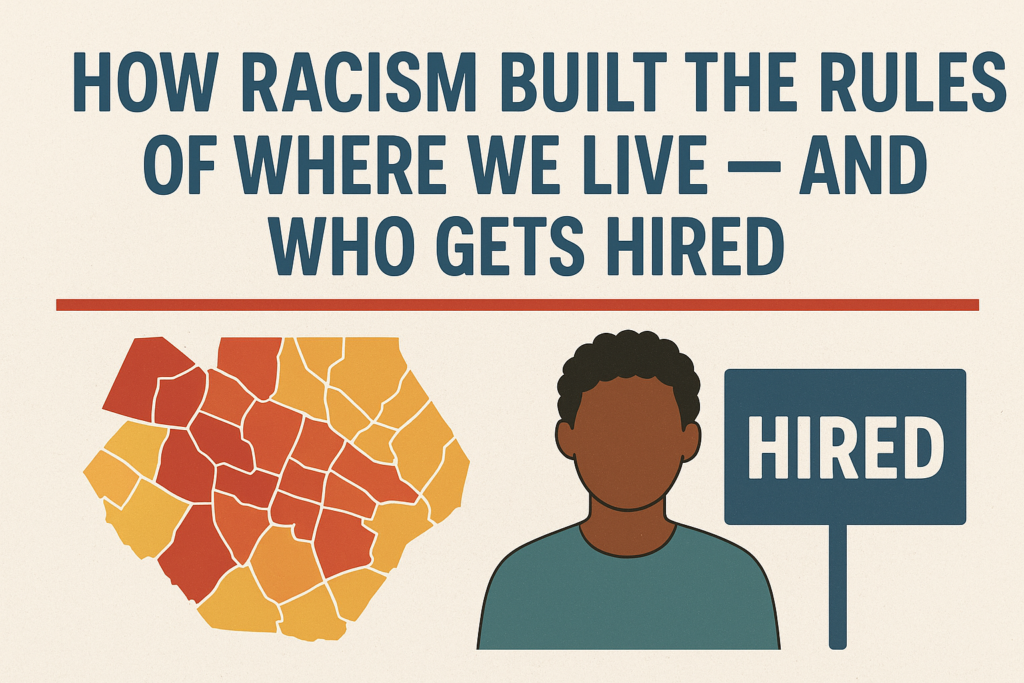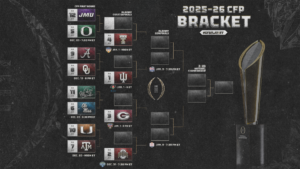Racism in the United States didn’t just show up as individual prejudice. For generations it was baked into public policy, bank lending, neighborhood maps and private hiring practices — creating structural barriers that persist today in where people live, the value of their homes, and who gets called back for a job interview.
Redlining: the map that wrote people out of the American dream
In the 1930s federal programs meant to expand homeownership helped create the modern housing divide. Government-created “residential security” maps graded neighborhoods by perceived risk — and neighborhoods with Black, Brown, or immigrant residents were routinely marked as risky and denied mortgage insurance. That practice, known as redlining, meant whole neighborhoods were cut off from mortgage credit, investment and generational wealth-building. The material consequences are measurable today: formerly redlined neighborhoods still show lower property values, greater disinvestment and worse health and employment outcomes. Digital Scholarship LabNCRC
Why it matters now: home equity is the primary source of intergenerational wealth for most American families. When large groups were denied access to fair lending for decades, the result was a persistent racial wealth gap: analyses show massive differences in median family wealth and homeownership rates between white families and Black and Brown families. BrookingsUrban Institute
Law and policy tried to fix things — but the damage stuck
Civil rights laws like the Fair Housing Act of 1968 outlawed overt discrimination in selling and renting homes. Later laws — including the Equal Credit Opportunity Act and the Community Reinvestment Act — aimed to force fairer lending. Still, enforcement gaps, subtle modern practices (like biased appraisals and algorithmic proxies), and decades of segregated housing patterns have kept Black and Latino families behind in homeownership and home value gains. Recent HUD and nonprofit studies document continued disparities in mortgage outcomes, appraisals and housing complaints. HUDHUD User
Hiring: the resume experiment that revealed name-based bias
Housing discrimination created segregated labor markets and unequal networks — but hiring discrimination operates on top of that. A landmark field experiment sent identical résumés to employers but changed only the names to sound Black or white; applicants with white-sounding names received about 50% more callbacks than those with Black-sounding names. That study and many others since show racial bias in who gets interviews, even when qualifications are the same. NBERAmerican Economic Association
More recent evidence: larger-scale audit studies — sending tens of thousands of résumés across cities and industries — have confirmed that Black applicants still face lower callback rates and are disadvantaged in particular sectors. Researchers also document “resume whitening” (where applicants alter names or experiences to seem less racialized) as a survival strategy, and continued gaps in hiring outcomes. ls.berkeley.eduScienceDirect
The two systems reinforce one another
When neighborhoods are segregated by race and wealth, that shapes the jobs people see, their commute times, childcare options and access to networks that lead to jobs. Employers that rely on informal networks, referrals or local hiring wind up reproducing neighborhood segregation. Likewise, biased hiring limits earnings and savings, which depresses homebuying power — a cycle that keeps inequality going. Economic and geographic exclusion therefore feed each other. (See Urban Institute and Brookings analyses on homeownership gaps and policy implications.) Urban InstituteBrookings
Modern forms of discrimination: algorithms, appraisals and advertising
Even when policies are neutral on paper, modern systems (credit-scoring algorithms, appraisal models, targeted advertising for housing listings) can recreate old inequalities by using proxies that correlate with race. Studies and federal reports have begun calling out appraisal bias (homes in majority-Black neighborhoods systematically appraised lower) and how digital ad-targeting can exclude groups from seeing housing opportunities. HUD and other agencies are investigating and taking steps — but critics say enforcement and transparency need to be much stronger. HUD UserInvestopedia
What the data shows today
-
Homeownership gaps remain large: the racial gap in homeownership and in home equity is a major driver of the wealth gap. Urban Institute+1
-
Complaints and enforcement: HUD and fair-housing groups continue to receive thousands of housing-discrimination complaints annually, evidence that discrimination is still common and often systemic. NFHAHUD
-
Employment discrimination: federal data and field experiments consistently find disparities in hiring and an uptick in discrimination charges to the EEOC in recent years. EEOC+1
What can change the picture? (Short and long term)
-
Stronger enforcement of fair housing and lending laws — including resources for testing, investigations and penalties. HUD
-
Targeted repair and investment in historically redlined neighborhoods (home repair grants, anti-displacement measures, targeted down-payment assistance). Urban Institute
-
Hiring reforms: blind/resume-redaction techniques, structured interviews, audit testing and stronger EEOC oversight can reduce bias in recruiting and selection. American Economic AssociationScienceDirect
-
Transparency in algorithms and appraisals: require audits and public reporting where automated systems affect credit, insurance or home valuation. InvestopediaHUD User
What readers in our community can do now
-
Know the history — understanding redlining and lending discrimination explains why neighborhoods and opportunity look the way they do. Digital Scholarship Lab
-
Demand accountability — support local advocacy groups pushing for robust fair-housing enforcement and anti-bias hiring policies. NFHAHUD
-
Vote for local housing solutions — local zoning, affordable housing, and inclusive development policies change outcomes where people live. Urban Institute
Racism in housing and hiring isn’t an abstract moral failing — it’s policy, practice and profit that stacked the deck. To fix it we need targeted policy, community power and employer practices that cut bias out of the system. Habari will keep reporting on the policies and local fights that aim to undo the legacy of exclusion and build pathways to real economic opportunity.











More Stories
Seasonal Storage Solutions That Keep Your House Clutter-Free
Seth Tabatznik Shines for Love in New Indie-Folk Single
Can the Arizona Cardinals Bounce Back Against the Dallas Cowboys on Monday Night?